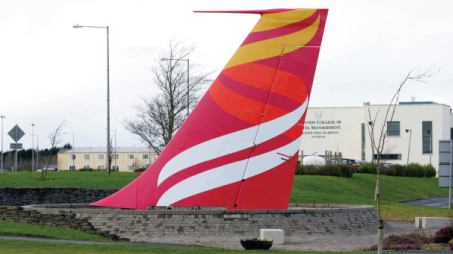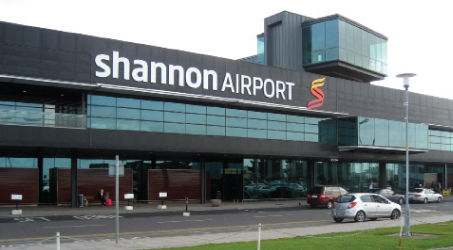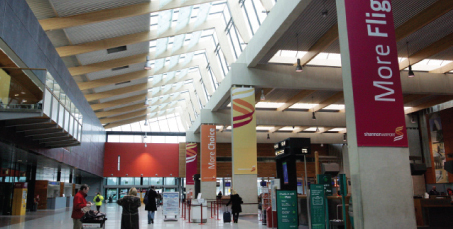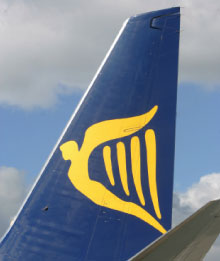
O’Connell: “For new long-haul routes at Shannon we offer annual discounts of 100%, 90%, 75%, 50% and 25% on passenger charges, aircraft parking, air bridge and runway movement charges over a five-year period – a full 100% discount in year one reducing to 25% in year five.”
Dublin Airport Authority is focused on developing sustainable passenger traffic at Shannon and has a range of incentive schemes that offer discounts of up to 100% on airport charges for new routes. The result has been several new routes and increased frequencies in recent months, including the launch of new Aer Lingus Regional services to Manchester, Birmingham, Glasgow, Edinburgh and Bristol, and new Aer Lingus services to Gatwick and Paris-CDG. Indeed, Ryanair has also expanded its presence at Shannon recently with the commencement of a new Fuerteventura service in February, as well as the reinstatement of its Nantes, Malaga and Palma-Mallorca services.
However, Ryanair is demanding that Shannon Airport pay it €4.70 for every passenger the airline brings to the airport. The airline claims its current operation at Shannon handles 300,000 passengers per year and it wants the airport to waive all charges and instead pay the airline for every passenger above that level. This is despite the 300,000 figure quoted being more than 100,000 below the airline’s current indicated traffic level at Shannon for 2011. Ryanair will also not pay landing or aircraft charges at Shannon for what it defines as any new passengers. Other demands include free check-in desks, free offices and free communications. Ryanair also insists the DAA returns the €3.7 million paid to settle the High Court case in January.
The settlement related to Ryanair’s failure to honour the commitments of its previous five-year agreement at Shannon Airport, which ran to April 2010. Ryanair also agreed to pay the DAA’s legal costs, amounting to several hundred thousand euro. Under the five-year agreement, the airline received a substantial discount on airport charges – between €1 and €2 per passenger rather than the standard €4 – in return for carrying an agreed number of passengers, rising to two million by April 2010. Ryanair met its targets for the first three years, but failed to do so in year four and then announced it was scaling back its Shannon operations. Therefore, under the terms of the agreement, Ryanair was required to pay the DAA compensation amounting to the full airport charge on the shortfall in passengers. The airline tried to invoke a ‘force majeur’ clause, claiming that the Irish government’s introduction of a €10 air travel tax made it impossible to reach the agreed targets. The DAA rejected this and launched the legal action, resulting in the €3.7 million out of court settlement.

Ryanair payed Dublin Airport Authority €3.7 million in an out of court settlement in January for failing to meet passenger targets under its five-year deal at Shannon Airport. The airline also failed to deliver the promised tourist numbers.
In addition to failing to meet passenger targets, Ryanair also failed to deliver the promised tourist numbers. When Ryanair launched the deal, it claimed that 80% of traffic into Shannon would be inbound tourists. However, on many of its European routes, 80% of traffic was attributable to Irish passengers travelling abroad with only 20% being inbound tourists.
Shannon seeking inbound tourist traffic
Brian O’Connell, Chairman, Shannon Airport Authority, explained that Shannon Airport cannot pay an airline for passengers, as that would result in financial ruin. “We value Ryanair’s current contribution to our passenger numbers, but there was no option but to reject the unrealistic demands they set out in their recent letter,” he said. “At a time when Shannon Airport is already loss making, there is no possible way we could pay Ryanair, or any other airline, for delivering passengers. It would be ruinous for the airport.”
Passenger growth is a key objective for the airport, in particular tourist passengers from central Europe and southern Germany. “We would welcome proposals from all airlines, including Ryanair, who offer such services and central to any such arrangement would be that in the region of 80% of these passengers would be inbound, in line with the traditional market we had in Shannon over 10 years ago. The region is continuing to under-deliver the quality and quantity of inbound passengers for the tourism product we have here,” O’Connell commented.

Passenger growth is a key objective for Shannon Airport, in particular tourist passengers from central Europe and southern Germany. O’Connell: “We would welcome proposals from all airlines, including Ryanair, who offer such services and central to any such arrangement would be that in the region of 80% of these passengers would be inbound, in line with the traditional market we had in Shannon over 10 years ago.”
Michael O’Leary, Ryanair’s famously bombastic chief executive commented “Ryanair is the only airline willing and able to deliver dramatic new route and traffic growth at Shannon and the refusal by the DAA of Ryanair’s 1m passenger growth offer proves, yet again, that Dublin Airport Authority has no interest in traffic growth at Shannon. If the DAA was ‘committed to incentivising growth’ it would have accepted Ryanair’s offer of 1m growth passengers at Shannon, on similar terms to those currently enjoyed by Aer Lingus at Dublin.”
The DAA strongly rejects Ryanair’s claim that the airline is seeking an extension of an existing incentive scheme available at Dublin Airport, insisting the demands bear no relation to any existing scheme at a DAA-owned airport. “The claim by Ryanair that Aer Lingus has such a deal in Dublin is completely untrue. No airline is paid money to bring passengers to any of DAA’s three airports,” said O’Connell.
He added: “We are in constant contact with airlines in relation to the opportunities at Shannon for new short-haul and long-haul services. We are also promoting use of the US Customs and Border Protection (CBP) facility at Shannon, which allows passengers to clear all US Customs, immigration and agriculture checks prior to departure. Shannon and Dublin are two of only a handful of airports outside North America and the Caribbean to offer this service to passengers.”
Incentive programmes

O’Connell: “We value Ryanair’s current contribution to our passenger numbers, but there was no option but to reject the unrealistic demands they set out in their recent letter. At a time when Shannon Airport is already loss making, there is no possible way we could pay Ryanair, or any other airline, for delivering passengers.”
DAA has a range of incentive programmes for airlines launching new routes at all three of its Irish airports. Under these schemes, airlines pay no charges during the first year of a new route and can also qualify for no charges for all passengers, if and when a target of 23.5 million passengers is reached at DAA’s three airports this year.
“For new long-haul routes at Shannon we offer annual discounts of 100%, 90%, 75%, 50% and 25% on passenger charges, aircraft parking, air bridge and runway movement charges over a five-year period – a full 100% discount in year one reducing to 25% in year five,” explained O’Connell. “For new short-haul routes operating on a year-round basis from Shannon, annual discounts of 100%, 75% and 50% on passenger charges, aircraft parking, air bridge and runway movement charges are available over three years – a full 100% discount in year one reducing to 50% in year three. For short-haul routes operating on a seasonal basis, seasonal discounts of 60%, 40% and 20% on passenger charges, aircraft parking, air bridge and runway movement charges apply over a three-year period.”
Ryanair has, at one time or other, operated non-stop flights to almost 50 destinations across Europe from Shannon. The number of destinations served at any one time peaked in 2008 at around 30. Between the summer of 2009 and 2010 Ryanair reduced its network from 25 destinations to just 10. Ryanair’s capacity withdrawals were responsible for around 90% of the decline in passenger numbers at Shannon Airport, which fell from 2.8 million in 2009 to 1.8 million in 2010. Ultimately, the business evolution of airports in Europe in the past 20 years, means that the non-negotiable terms set out by Ryanair are a real challenge to many of Europe’s regional airports. While Shannon Airport is committed to incentivising growth, that must clearly be achieved in a way that is financially viable for both the airport and the airline.







